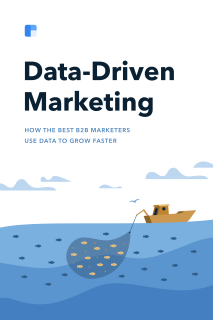Chapter 8
24 minutes
Personalized Drip Sequences

Anna Jacobsen Principal at SI Consulting
You know that horrible feeling you get when you send an email and only 15% of the recipients open it? Or worse, when you get an abysmal open rate and a major promotion is riding on the success of that email?
Hopefully you’ve never felt that pain. But the fact is, most marketing teams put an enormous amount of time and energy into email marketing and still aren’t getting a meaningful bump in new customers.
Even sophisticated marketers can fall into the trap of using outdated email marketing tactics. Rather than finding ways to be more specific, more insightful, and more personable in email, we focus on crafting clever copy broadly sent to seven-figure lists, imagining that is the path to the greatest conversion lifts.
And then we wonder why our unsubscribe rates are so high, or why the return on our enormous investment in email is so low.
In this chapter, I’m going to tell the stories of three companies that have turned their automated email campaigns into stunningly effective outreach methods, with real numbers for proof. These companies started sending emails driven by behavioral and persona data, and saw overnight improvements.
Because of these tactics, these companies are able to rely on email as a major, sustaining channel of growth.
- How Scott Moran, co-founder of SamCart, segmented his list using subscribers’ engagement with his marketing campaign to fuel a seven-figure SaaS product launch
- How Brennan Dunn from Double Your Freelancing increased his conversion rates by 250% using persona segmentation
- How Nate Grahek and the StickyApps team’s use of well-timed, user-generated copy increased engagement by 300%
We’ll share the best email examples so you can see the personal touches they use. We’ll also hear from Drift’s David Gerhardt about timing their onboarding and activation emails.
Finally, you’ll see the survey results from two “state-of-the-union” questions about email marketing at B2B SaaS companies today. What data are companies using to segment their email lists these days? And what email marketing metrics are the most useful to track and make decisions by?
These questions come from an original B2B marketers survey we ran on Email Segmentation and Email Performance Metrics, and you’ll get the first glimpse at the answers from over 100 marketers here. It’s my hope that you’ll be able to benchmark your own email systems and be inspired to construct dynamic drip campaigns that resonate with your leads.
Let’s first look at how to cleverly and dynamically segment and nurture funnels for better product purchases at the end of the funnel, starting with SamCart’s launch story.
How SamCart found and nurtured their most-engaged leads during a product launch campaign
Brian Moran, co-founder of SamCart, believes you should never release a product to an empty room.
In September 2016, SamCart did its first public promotion for SamCart Premium, a new product that was coming out of paid beta. They decided to generate buzz with a limited-run offer available only during launch week. And it was a sweet deal: instead of paying the normal $199/month price, customers could get one year of SamCart’s premium subscription for just $99/month, plus bonuses (like training courses and another free subscription)—and keep the grandfathered price forever.
SamCart’s goal was to generate as many sales as possible when they opened the launch cart, and at the center of the launch was an exclusive opt-in video campaign with self-segmenting nurture emails.
The three videos educated users about how to create better checkout and sales pages, and were gated for two weeks to attract new subscribers to the launch list.
Then the videos were released via email in succession, starting two weeks before the cart opened.
- Wednesday, September 7: Video 1, “The New Way To Sell”
- Monday, September 12: Video 2, “2 Ways To 4X Sales”
- Thursday, September 15: Video 3, “The Blueprint To Freedom”
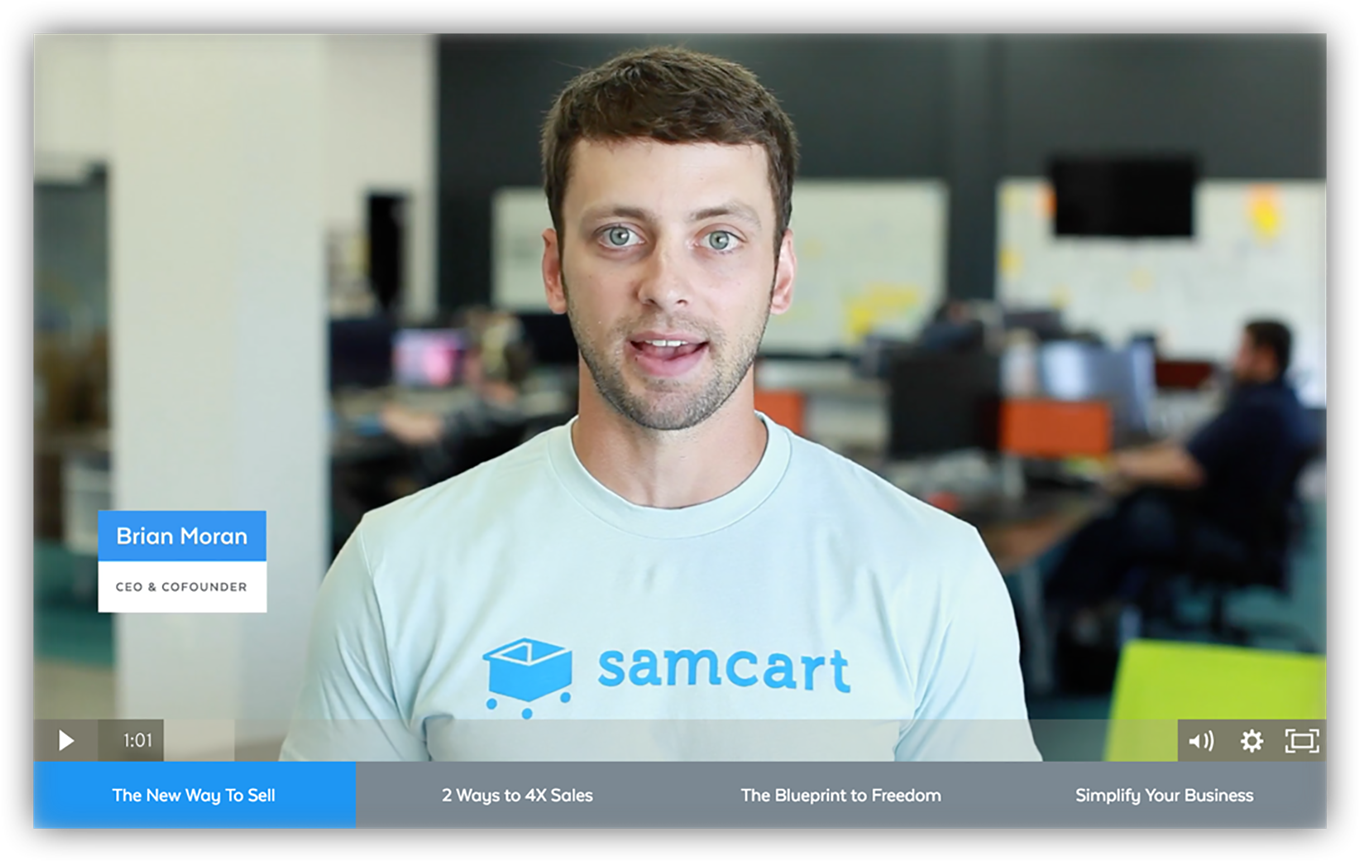
Here’s an excerpt of an early email that revealed video #1. The call-to-action is to “watch the video.”
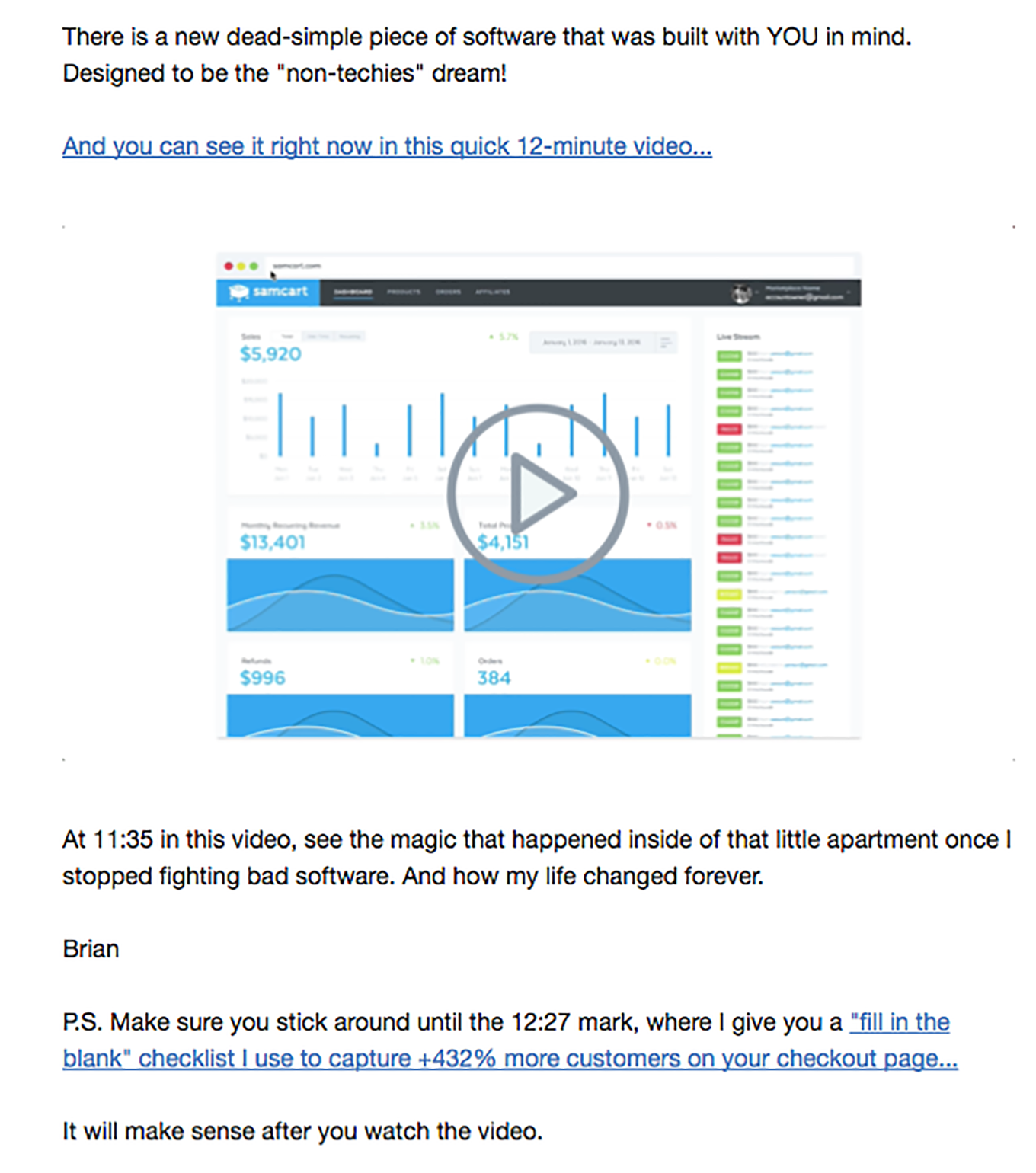
But they didn’t just drop the videos in people’s inboxes and leave them there. They wanted to make sure people were watching the videos, and if they did, offer them even more engaging “carrots” to increase the likelihood that they’d purchase at the end of the campaign.
So they started segmenting and personalizing. They started out with these main lists:
- Segment 1: SamCart’s general marketing list
- Segment 2: SamCart Premium launch list
- Segment 3: The subscribers from segments 1 and 2 who had watched launch videos as the campaign progressed, with sub-segments for people who watched videos 1, 2, and 3
The team created over 20 unique emails across the different segments to promote the videos and nurture the upcoming launch, and they sent an email to each target segment nearly every day. The marketing list would get general emails to drum up intrigue for the videos.
The launch list would get emails advertising the videos, and the email copy was highly focused on the key takeaways from the video. Then, they’d receive daily follow-up emails to remind them to watch. Each video played a crucial part in the pitch, explains Scott Moran, Brian’s co-founder and brother, so it was important strategically to ensure that people saw it, without bombarding those who were engaging with the content.
Here’s where SamCart engineered a smart trick to collect data about how users interacted with the video campaign. The videos, hosted by Wistia, could detect how much the user viewed. They set a marker for when a video could be considered “watched”: 20% of a video. Wistia pinged that information to Drip, which tagged that user (with “watched PLC1,” for instance). The user was moved to the list of subscribers who’d watched that video.
“If you hadn’t seen the first video, it was imperative that you do so before moving on. So those first five days of emails, we were sending everybody back to PLC 1,” says Scott. “But we excluded people who had already watched it, based on tags.”
Over time, they slowly ushered the entire launch list through the three videos until the sales cart opened, maximizing everyone’s potential to be engaged with the content.
Of course, the “super fans” didn’t get daily reminders to watch videos, but it’s not a good marketing strategy to ignore prospects who are engaging with your content. These folks received special emails with new CTAs to keep excitement high.
- Teasers for the next video in the series
- Free downloadable content (such as “Download the PDF report”)
- Invitation to join their conversion-focused Facebook group
- A free trial offer
“We weren’t going to ask anyone to start a free trial if they weren’t even interested enough to watch the pre-launch content. For folks who were engaged, we gave them a chance to try SamCart,” Scott explains.
The campaign yielded an astounding ROI and a seven-figure launch week. Results included 25,000 new subscribers, 100,000 video views, and a $2.3M launch.
What we can learn from SamCart is not only to nurture your email list frequently during an active campaign, but also to alter the CTAs based on the recipient’s level of engagement with your brand and product. You can detect that engagement automatically, segmenting users into finer groups as the campaign progresses.
SamCart’s way of doing this was to create a Wistia video campaign that could send viewership data to their email client. If you need a different way to segment subscribers by engagement, think about what other triggers you might have access to—such as a user’s pageviews on your website (did they check out product page 1 or 2?)—or get lead-scoring data that connects to your email automation software.
Tip: Prune Uninterested Subscribers to Boost Deliverability
If daily emails seem like a lot of contact, Scott acknowledges that “we’re a little bit persistent with our emails.” But the hope was not to be spamming subscribers—rather, it was to encourage them to take action and be fully informed before making a purchase decision.
An important part of not spamming your users is to clean your email lists. Data is helpful here too, because some email clients can analyze your subscribers’ engagement activities and recommend which ones to drop.
SamCart does this regularly with subscribers who haven’t opened an email in 60 or 90 days. But instead of only using automation to prune a large swath of subscribers who haven’t opened or clicked, they combine Drip’s data with some manual pruning.
“When we clean our list, we don’t have any set rules. We approach it with fresh eyes,” Scott says. “We start messing around with rules and use Drip’s pruning tools as a baseline number for analytics without actually performing a prune.”
Then they spot-check those numbers, looking at individual subscribers in the segment that their email tool recommends they prune, examining their behaviors and characteristics. “Each subscriber has their own journey,” Scott says. “Looking at a selection of individuals gives you a much better idea of what’s happening, because you can get really granular.”
So as you consider pruning your own email lists, look beyond basic email open rates and click history to understand who your unengaged subscribers are.
We just learned how SamCart segmented nurture emails based on a user’s engagement with their video marketing campaign. Let’s meet Brennan Dunn, who segmented nurture emails using customer personas, which improved conversion rates by 250%.
How Double Your Freelancing used personas to segment nurture funnels
Marketers often struggle to create relevant pitches in emails, especially when a product serves multiple customer personas. “Unfortunately, many of us create messaging that attempts to speak to everyone, which means we’re actually speaking to no one,” says Brennan Dunn, founder of Double Your Freelancing.
Double Your Freelancing is an education company that helps over 40,000 freelancers run their businesses. It’s a perfect embodiment of the multiple-markets issue because they serve many personas. The most common customers are agencies, developers, designers, writers, consultants, photographers, and marketers.
At first, Brennan wanted to improve conversion rates by specializing his products to focus on just one of these niches.
But when he looked behind the scenes at the way users were interacting with his courses, he saw that Double Your Freelancing was truly solving real problems for all of them. It wasn’t that he needed to specialize his product; he just needed to personalize his marketing. And indeed, his audience had struggled to identify with his marketing in the past, like when he targeted subject lines to developers and heard confusion from designers.
So he started thinking about his marketing copy in terms of multiple versions that would answer a key question for his main personas: “How does this help me to solve my own special, unique pain points?”
To start, he tailored a free nine-part email course by changing the marketing and educational copy so it spoke to specific segments. This email course, Charge What You’re Worth, was one of Double Your Freelancing’s best subscriber growth channels. It taught freelancers how to raise rates, and then it upsold them to other Double Your Freelancing products.
Brennan made a copy of the generic course for each persona, and edited the subject lines, calls-to-action, and body copy. Using “if/then” liquid conditionals, he also inserted specific offers and testimonials into the emails.
Next, he needed an automated way to send the right course to new subscribers, so he used his opt-in form to segment them right away. On the landing page, he asked them to enter their email address and specify “What do you do?” with a drop-down form.
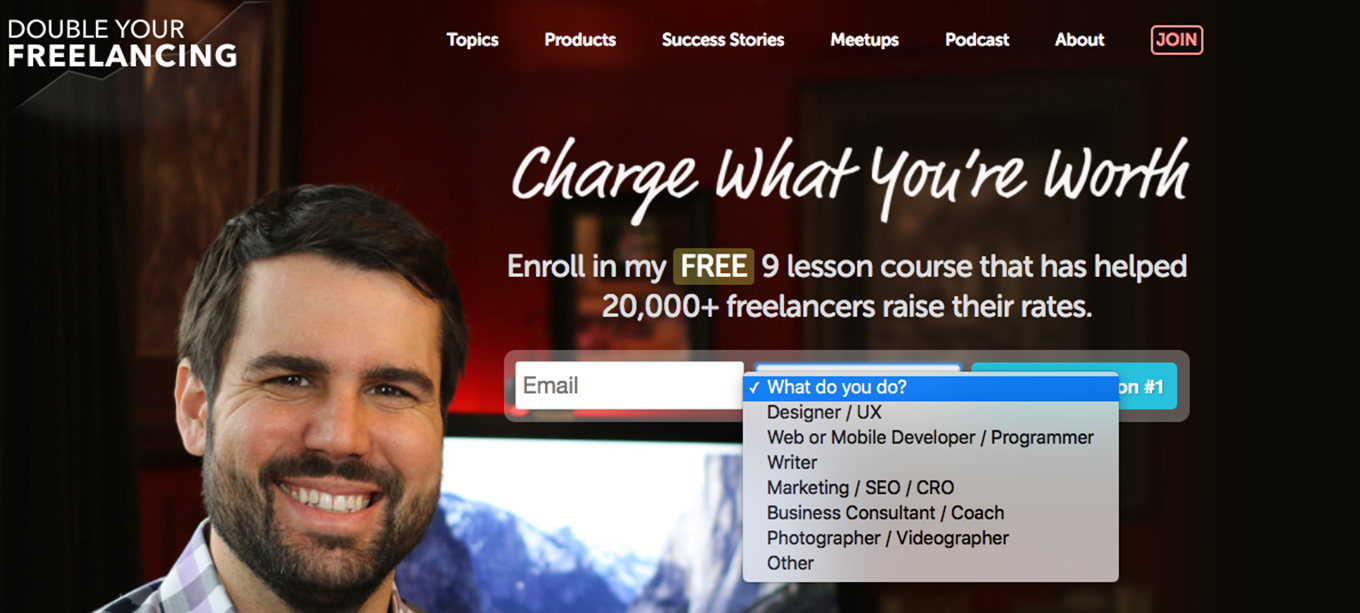
DYF landing page opt-in
The course that arrived in a developer’s inbox would speak to the developer mindset, which was different from the course that landed in an SEO’s inbox. The core principles of the course remained unchanged, but the approach and positioning of the email now matched the person receiving it. For Double Your Freelancing, this personalization increased conversion rates by 250%.
Tip: Start small When you want to personalize emails, consider starting with just one email marketing campaign that’s already been successful. Focusing on just one funnel will allow you to execute more quickly and see quick results and validation.
For B2B SaaS companies, segmenting new subscribers or leads can be even more automatic.
When a new lead provides you with an email address, you can use third-party enrichment data to learn about the company they work for and then funnel them into a segment based on industry, company size, geography, and more.
This actually removes the need for them to answer “What do you do?” You can collect that information on the backend, or you can auto-magically fill the rest of a lead form and ask the user to confirm its accuracy by clicking “Submit.”
There are so many potential data points you could use to segment your email lists, from engagement (like SamCart did) to personas (like DYF did) to industry and lead score and more.
Out of all these options, what do B2B SaaS companies typically segment for? We asked 113 email marketers to share what their companies use, and here’s what we found.
Most common B2B email list segmentation parameters
Source: Clearbit B2B marketers’ data-driven email survey, August 2017
What parameters are B2B companies using to segment their email lists?
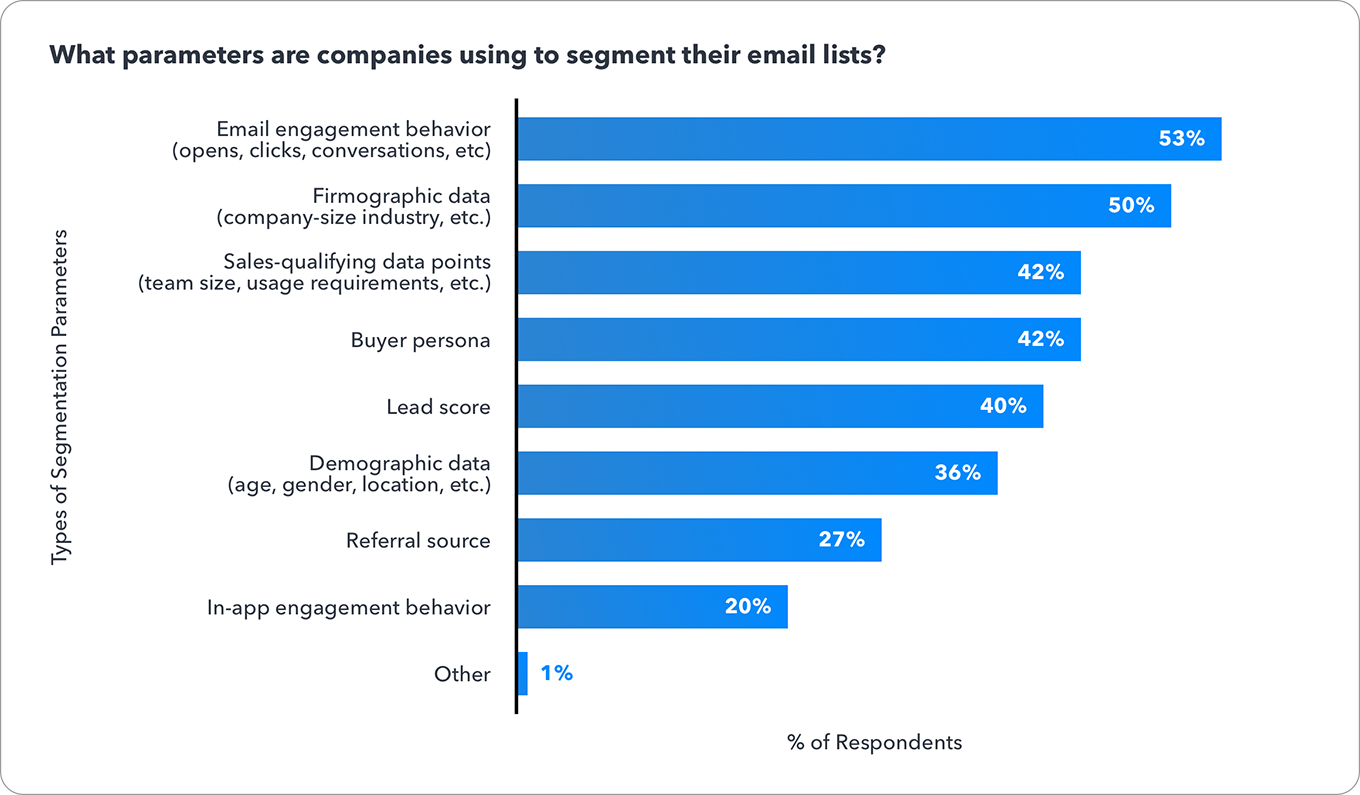
Eight types of email segmentation parameters and the percentage of respondents that use them:
| Param | % |
|---|---|
| Email engagement behavior (opens, clicks, conversions, etc) | 53% |
| Firmographic data (company size, industry, etc.) | 50% |
| Sales-qualifying data points (team size, usage requirements, etc.,) | 50% |
| Buyer persona | 42% |
| Lead score | 40% |
| Demographic data (age, gender, location, etc.) | 36% |
| Referral source | 27% |
| In-app engagement behavior | 20% |
| Other | 1% |
Takeaways:
The good news is that all companies who responded were using some segmentation for their lists. Forty-four percent of respondents used just one or two of the listed segmentation parameters, but more than half used three or more. A couple of brave souls sliced it with seven different types of categories (and probably with detailed cuts within those categories).
The most common parameter type was email engagement behavior: placing people in different groups based on whether they are opening, clicking, or responding to emails. Next was firmographic data such as company size and industry, which was more commonly used than demographic data such as the individual person’s age and gender. And 42% of companies used buyer personas like Brennan Dunn did.
The link between sales and marketing showed up here, with 42% of respondents segmenting with sales-qualifying data points and 40% using a lead score.
One area that could use some work was tracking a user’s behavior within the company’s actual product or app, and then piping that back into the email lists and segmenting accordingly—20% of companies were using this practice.
Let’s revisit the most popular segmentation practice, which relates to the way a user engages with your marketing efforts. We took a closer look and asked companies to clarify which engagement behaviors across their emails, content, website, and app they used to segment email lists.
What engagement behaviors are B2B companies using to segment their email lists?
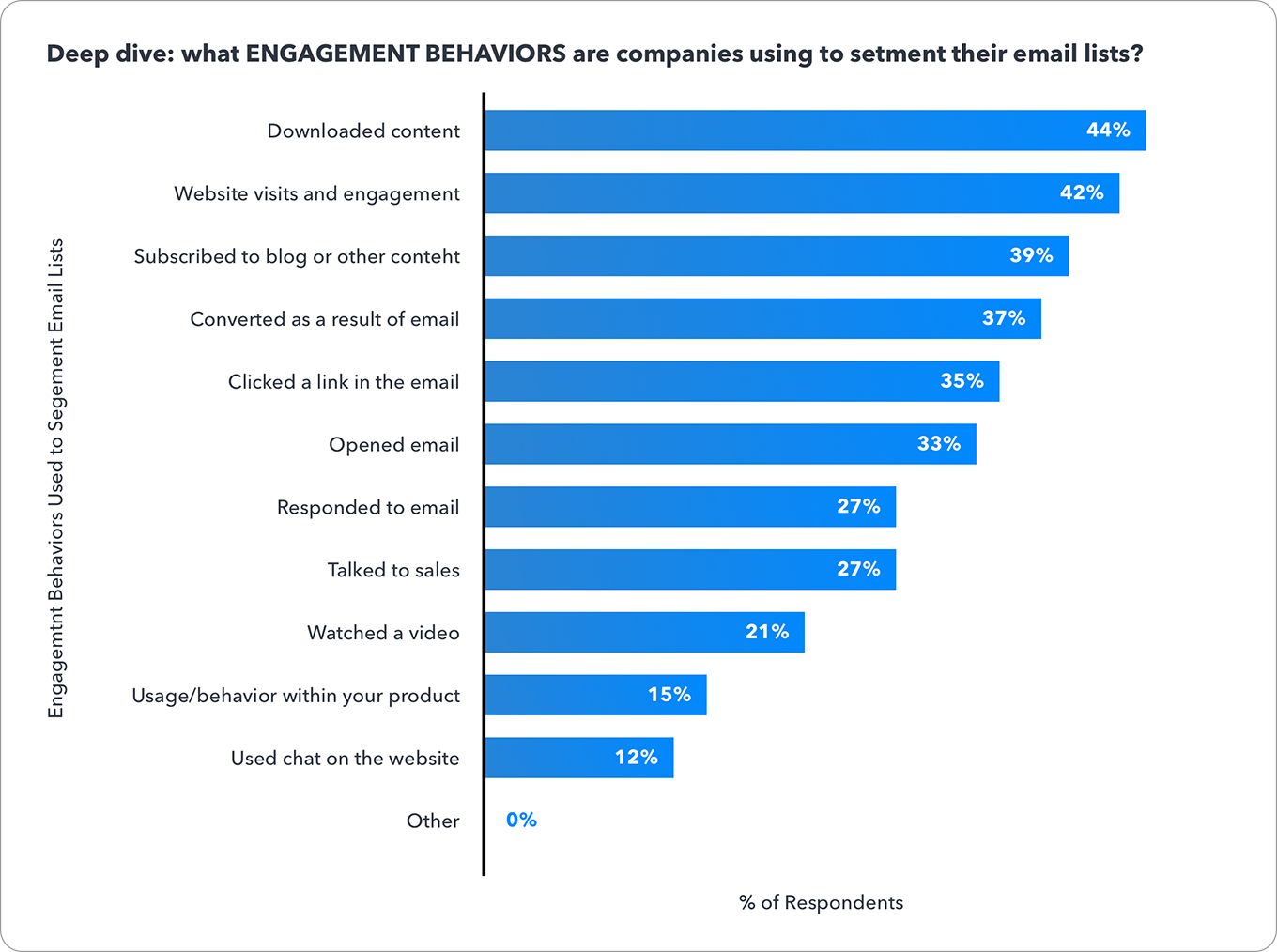
Engagement behavior-based email segmentation parameters and the percentage of respondents who use them:
| Param | % |
|---|---|
| Downloaded content | 44% |
| Website visits and engagement | 42% |
| Subscribed to blog or other content | 39% |
| Converted as a result of an email | 37% |
| Clicked a link in an email | 35% |
| Opened an email | 33% |
| Responded to an email | 27% |
| Talked to sales | 27% |
| Watched a video | 21% |
| Usage/behavior within your product | 15% |
| Used chat on the website | 12% |
Takeaways:
Content is a widely used tool for segmenting email lists. The most common way to segment (among the 11 listed behaviors) was to group users by the relevant content downloads they’d signed up to receive (44%). And 39% of companies used blog subscriptions in general to delineate segments.
Then there was email-based engagement. Of all respondents, 37% tracked whether a user converted as a result of a marketing email and segmented them accordingly. Others segmented based on whether someone opened an email, clicked a link in it, or responded to it.
And the sales-marketing link showed up here as well, with 27% of respondents segmenting users based on whether that lead had talked to the sales team.
So we just talked about how to segment email lists and personalize emails to better upsell products later. Next, we’re going to talk about how to put a personal touch on emails for your new and current customers to keep them engaged during onboarding.
StickyApps’ data hacks for personalized engagement emails
Nate Grahek is the founder of StickyApps, a SaaS product which helps photographers create one-page marketing websites for small business owners (like wedding vendors and other small businesses).
This is a story about how Nate’s team kept customers engaged through very personalized emails. But it’s also about hacking it when you don’t have access to awesome data or perfectly connected marketing tools.
A key part of StickyApps’ onboarding and activation is a course that teaches photographers how to use the tool and gain some soft skills to grow their business. The most successful users completed the course, but unfortunately, the overall completion rate was only 10%. This was standard for similar courses in Nate’s industry, but it completely undermined the power of the StickyApps product to help new users be successful.
Nate decided to nudge new users through the onboarding course with automated motivational emails, and he created two interesting workarounds to do so.
The first step was to figure out where customers hit roadblocks in the course so that Nate and team could shoot them a coaching email. Unfortunately, the learning management system Nate used didn’t have granular tracking abilities.
So they set up Typeform surveys at the end of a module that a user marked when they completed the module. Nate used Zapier to send those completion events to Drip, their email marketing tool. So the workflow was Typeform → Zapier → Drip. Then Drip would wait for the completion event to fire, and after a sufficient delay, a “stalled” tag would be applied automatically to those users.
This illustrates the idea that you don’t need to let a feature limitation hinder your tracking and data collection. You can use tools like user surveys and Zapier to backfill what’s missing.
The next step was to personalize the outreach emails. A few were generic, like this one:
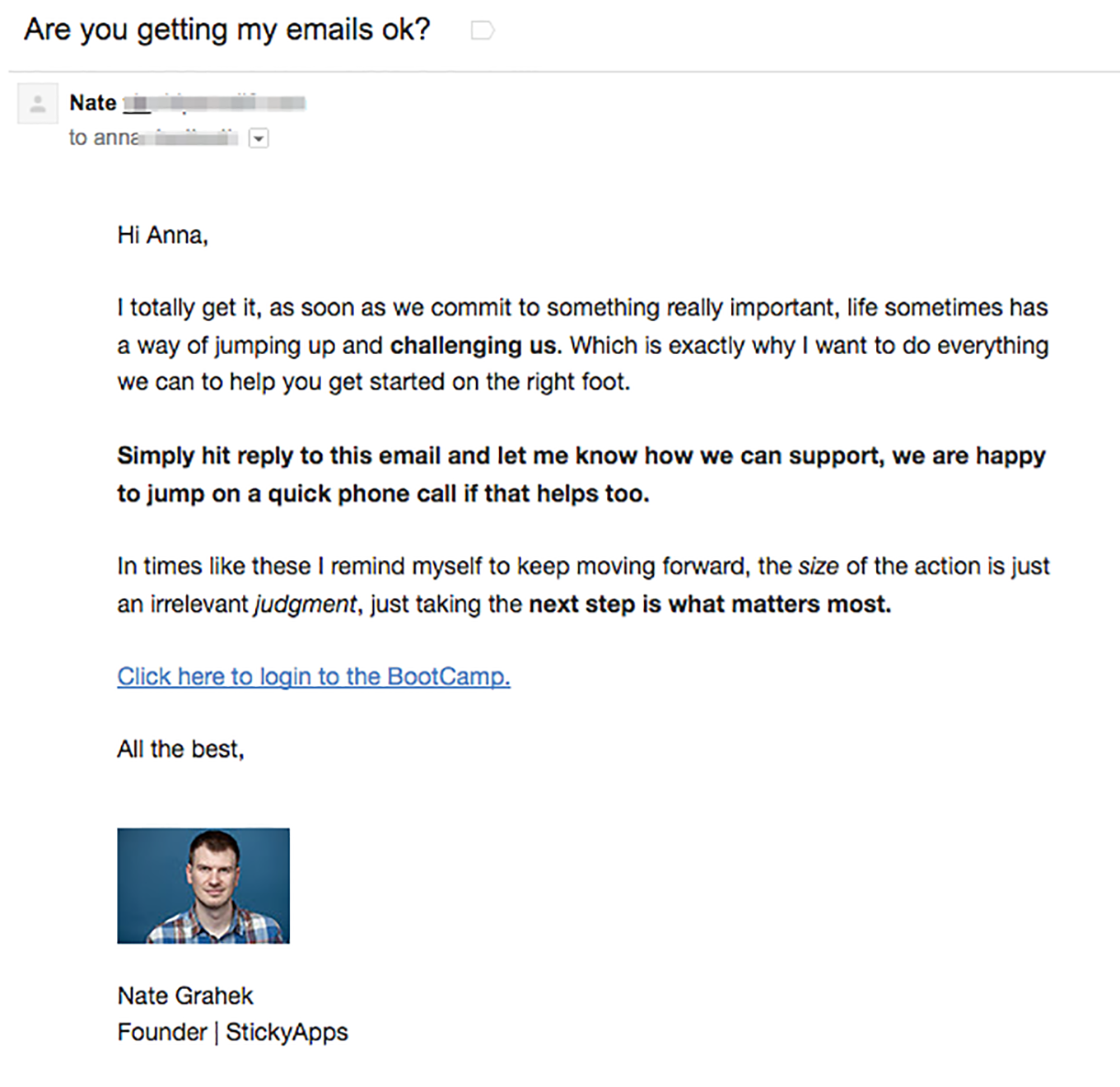
But he got hyper-personalized data by running a survey at the beginning of the course. It was called a “Commitment Plan,” and it asked students about their motivations for signing up for StickyApps, with questions like the following:
- Take a moment to reflect on what attracted and motivated you to sign up for this program.
- What pre-existing goals did you see this helping you achieve? What pre-existing problems did you see this being a solution for?
- I want you to imagine that you are almost done with the bootcamp, but you hit a setback, and you are feeling overwhelmed.
- Below, write a short message of encouragement to your future self.
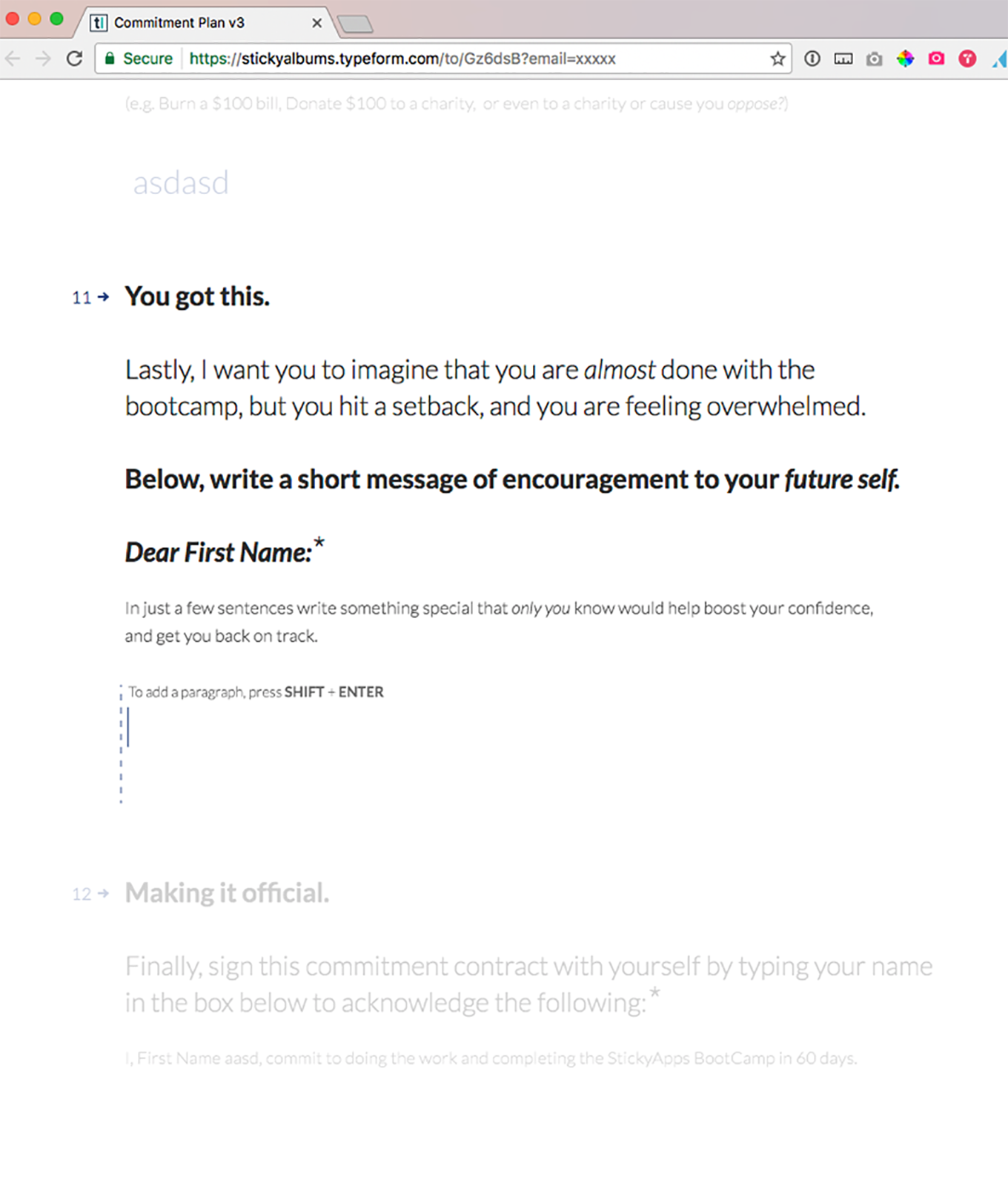
Users submitted the survey and started the course. Later, when users hit a red flag event for inactivity in the course, StickyApps sent a personalized email that parroted the user’s words in the survey right back to them.
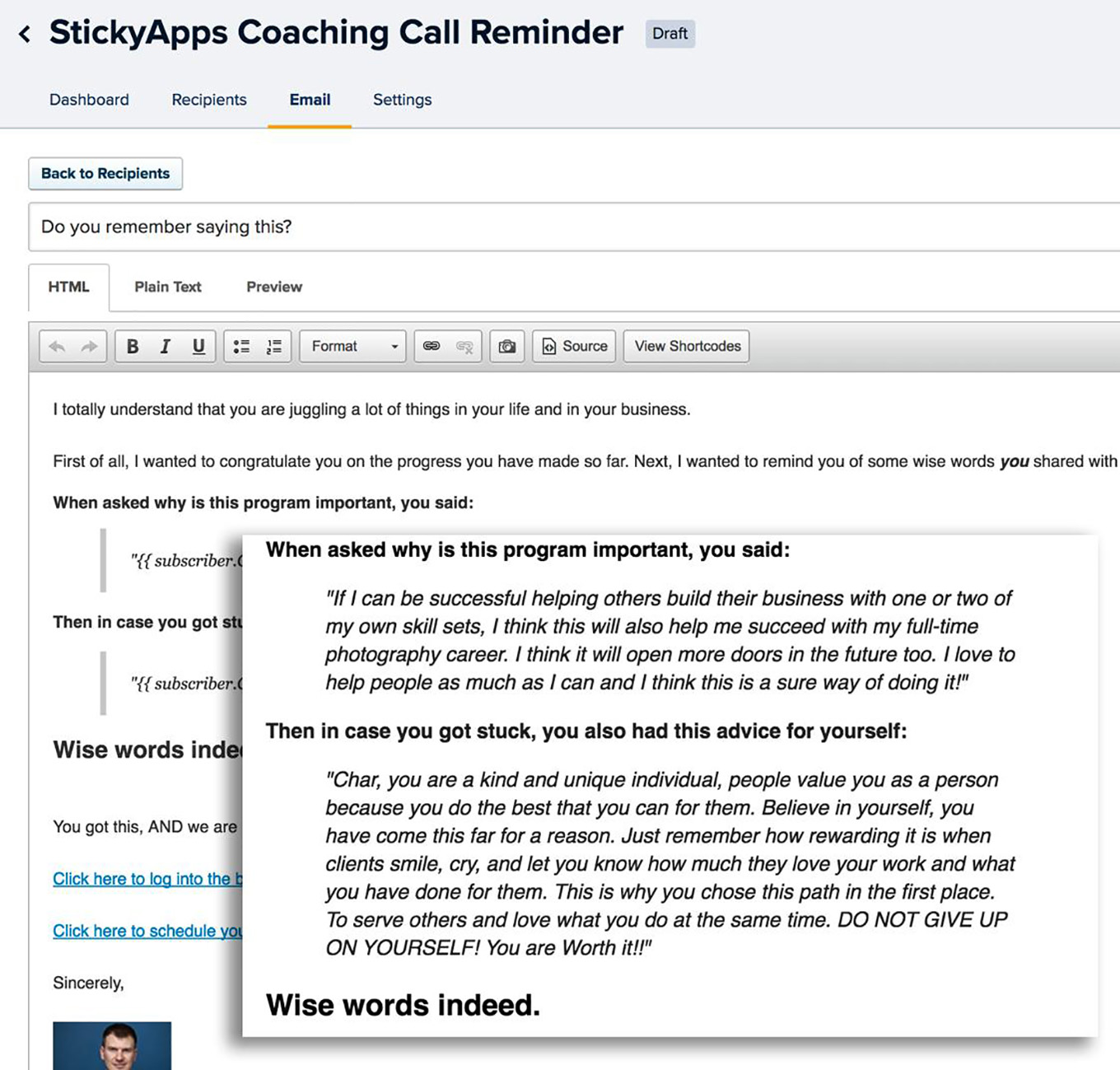
Please don’t miss the genius behind how this email was generated. The answers they collected from their Typeform surveys were Zapped into their email marketing tool as custom fields. Using Liquid, these custom fields were then automatically inserted into the email body.
Nate points out that the self-motivational copy sounds cheesy as marketing copy. Nate would never have written something like this (no one on his marketing team would have, either). They couldn’t say this kind of stuff to a client without coming off as a little trite. But because these emails were powered by the learner’s own words to themselves, they ring true.
The StickyApps course completion rate went from 10% to 40%, blowing typical course completion rates out of the water.
This shows that well-placed surveys and intake methods can provide insight that passive marketers would otherwise miss. Get as close as you can to your audience’s mindset. The StickyApps technique of leveraging their users’ own words is about as close as you can get to mirroring your audience’s mindset back to them, and it demonstrates deep understanding of the individual on the other end of the conversation. Especially in high-risk, high-pressure, or high-emotion conversations, empathy wins the day.
Drift’s email timing
As we know from Nate’s story, getting the timing right for engagement emails is important during sensitive periods like onboarding and activation. We talked to David Gerhardt, Marketing Director at Drift, about his tips for uncovering sticking points and reaching out to the right people at the right time.
When a user signs up for a Drift account, they need to send three chats for Drift to consider them “activated.” That seems to be the magic number of chats to signify that people are up and running, and it’s still early enough for Drift to reach out and engage them further.
They looked at customer data on when people were activating and saw that there was an opportunity to re-engage with an activation rescue email after 14 days. Then, after monitoring the data a bit, they realized that was too long of a wait and they moved it up to just a few days. The lesson? Timing is something you should test and adjust. “I think the biggest mistake a lot of companies make at this stage is not picking something. We picked a number, tested it, and started to learn,” says David. “You can always change it later.”
Here’s another tip. To understand onboarding patterns, definitely look at your data, but also talk to customers. David says:
“The number one secret is also the most obvious: you have to ask. One thing we started to do was to send an email to people who didn’t activate after a certain period of time and ask why. We uncovered two big learnings from that email. Some were customers with lower-traffic websites, meaning that they didn’t have the traffic to generate three chats quickly. So we pushed out the emails for that group a bit. The other thing we learned was that because of our freemium model, a lot of people sign up, poke around, and then need help from their web developer or an engineer to copy and paste the Drift code on their website, which might take an extra day or two. Both of those insights have taught us that we needed to space out our onboarding emails a bit—but that we really have 10 days to get people up and running.”
Email metrics
Now that we’ve talked about how email drips can improve your sales and product engagement, you’ll want to measure how well they’re performing.
Most email marketing tools come with fairly decent tracking to see who’s engaging. But there’s a rich world of email measurement out there, and ultimately, you want to know whether your email drip campaigns are leading to new business, and you want to make sound decisions about how you’re investing your marketing budget.
We wondered, out of all the ways you can track emails, which metrics are B2B marketers actually using today?
The most helpful B2B email marketing metrics
Source: Clearbit B2B marketers’ data-driven email survey, August 2017 (N = 113)
We first asked marketers which email metrics they actively track, to get a sense of how advanced companies are in this realm.
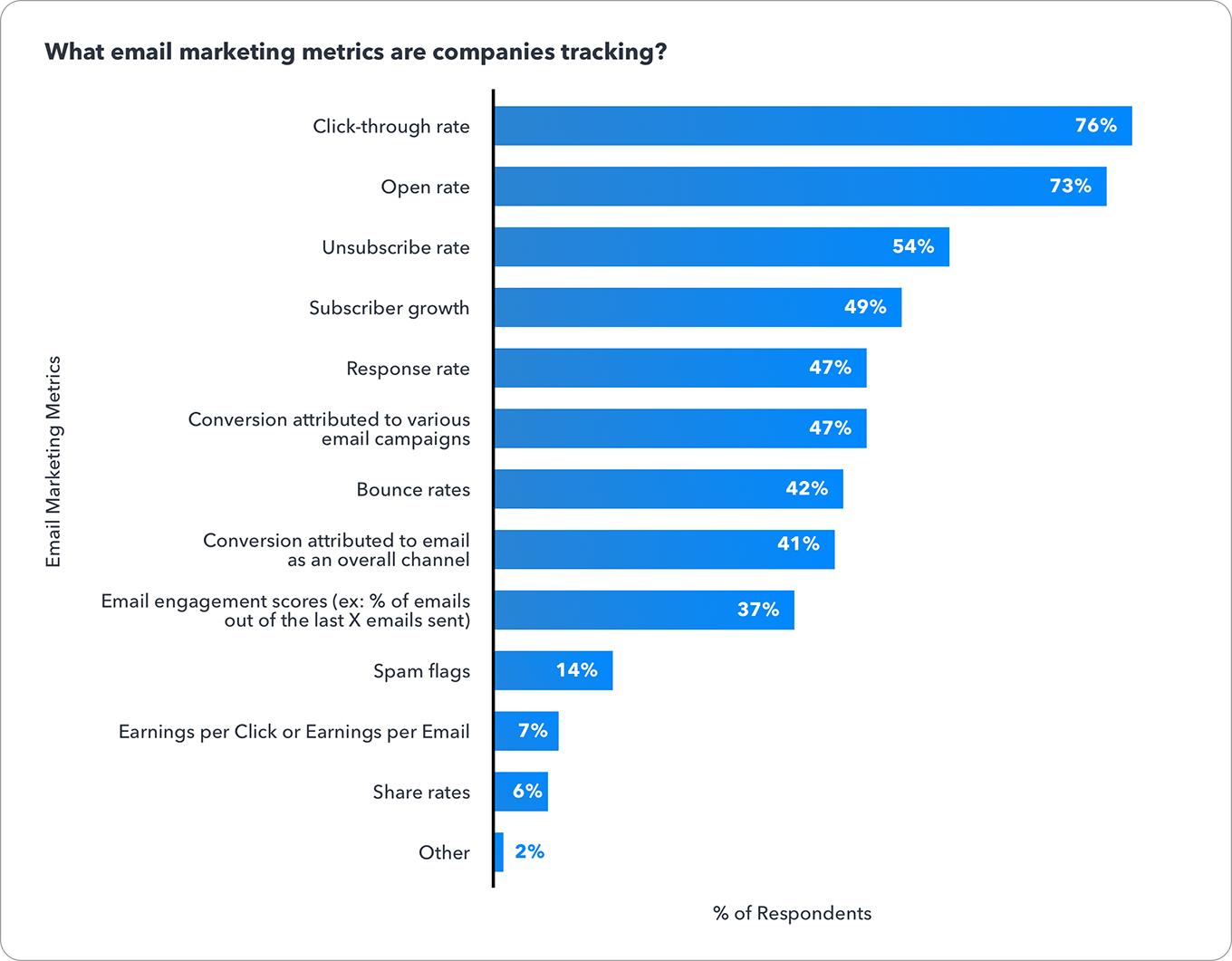
B2B email marketing metrics and the percentage of respondents that track those metrics
| Metric | % |
|---|---|
| Click-through rate | 76% |
| Open rate | 73% |
| Unsubscribe rate | 54% |
| Subscriber growth | 49% |
| Response rate | 47% |
| Conversions attributed to various email campaigns | 47% |
| Bounce rates | 42% |
| Conversions attributed to email as an overall channel | 41% |
| Email engagement scores (ex: % of emails opened out of the last X emails sent) | 37% |
| Spam flags | 14% |
| Earnings per Click, or Earnings per Email | 7% |
| Share rates | 6% |
| Other | 2% |
According to the results, it was more common for companies to track metrics that compare conversions from one email campaign over another than it was to track conversions from email as an overall channel (as compared to other marketing channels). That is, this could suggest that checking which email campaigns are most effective is more common than proving that email is effective as a whole.
Very few companies (7% of respondents) tracked revenue earnings per email or per email click.
What email marketing metrics actually matter?
Of course, just because you track an email metric doesn’t mean you use it. We asked marketers to share the top metrics they truly cared about—those they used to actively make business decisions on a regular basis.
This chart compares which metrics respondents tracked (from the previous question) versus which ones they cared about (they could only mark their top three).
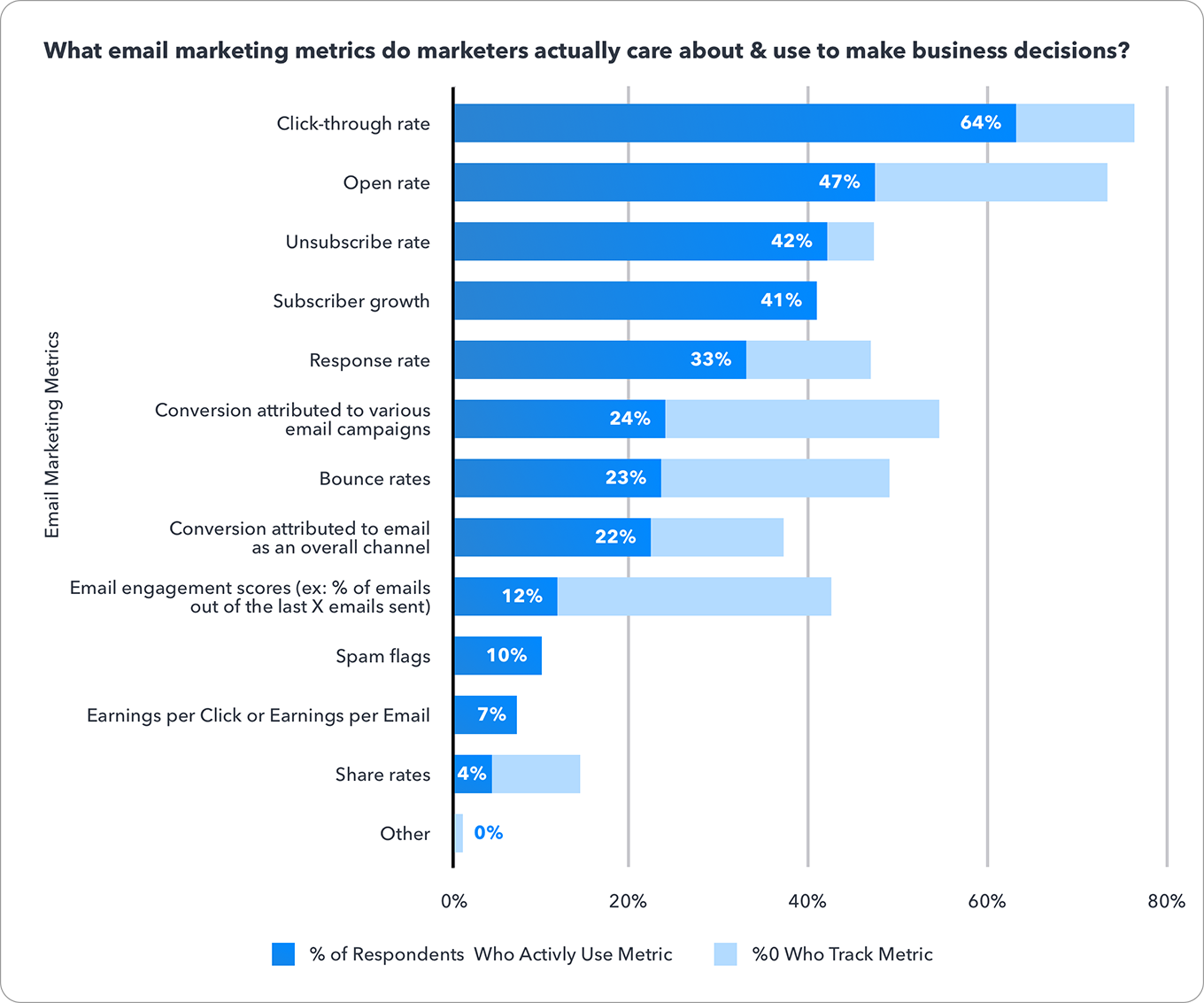
B2B email marketing metrics and the percentage of respondents that actually care about them
| Metric | % |
|---|---|
| Click-through rate | 64% |
| Open rate | 47% |
| Conversions attributed to various email campaigns | 41% |
| Conversions attributed to email as an overall channel | 33% |
| Response rate | 24% |
| Unsubscribe rate | 23% |
| Subscriber growth | 22% |
| Email engagement scores (ex: % of emails opened out of the last X emails sent) | 41% |
| Bounce rates | 12% |
| Earnings per Click, or Earnings per Email | 10% |
| Share rates | 7% |
| Spam flags | 4% |
Takeaways:
Several survey respondents shared with us that they know email measurement and segmentation is important, but they’re currently behind where they’d like to be in terms of what they’re able to track—such as the marketer in a large company who lamented the difficulty of finding and managing data in their legacy enterprise tools. But they were also hopeful about the future and about putting new systems in place.
And conversions were key. Nearly all of the marketers who tracked conversions used that metric to make business decisions, either to compare two email campaigns or make decisions about email as an entire channel. Open rates, in comparison, were less important to inform actual decisions.
Click-through rate remained the favorite metric—76% tracked it and 64% used it to make business decisions.
I hope I’ve convinced you to infuse your drip emails and lead nurturing efforts with more data so that you improve conversion rates and keep users engaged. There’s no reason to treat all recipients the same anymore.
You can use third-party data to automatically personalize and segment emails into groups, or you can use data about how users are interacting with your overall marketing campaign (are they opening, watching, and reading content?). Make sure to create custom copy and personalized subject lines, too. And if you don’t have access to great data or well-connected marketing tools, you can hack it with surveys and Zapier.
And the last thing? Make sure you measure how spectacularly your new emails perform.
